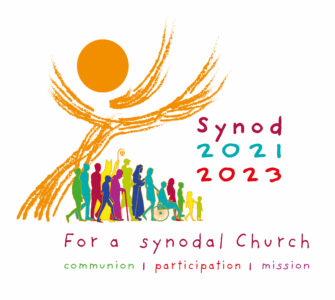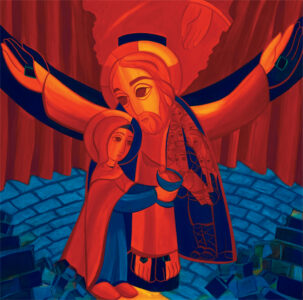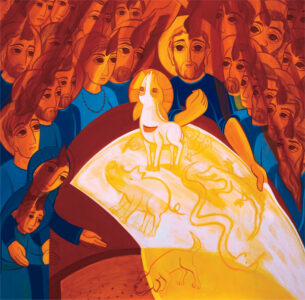What on earth is the Synod on Synodality?!!!

When I was a boy we had a party line telephone in the house. Because we were in the countryside we shared the line with several other households. Each household had their distinctive ring – long, short, long, for example. When you heard your ring, you answered the call. Of course, you couldn’t ring if someone was already on the line. Sharing a line did have its disadvantages. One neighbour took sharing more literally – she used to listen in on others’ conversations – sort of inviting herself to the party! To ring someone, you had to call up the exchange and ask for a certain number. The operator at the exchange would physically plug your line into the receiving line.
You can imagine our wonder when all this was automated. We got a phone with a dial! Anyone younger than 40 probably won’t remember dial phones – they were superseded by telephones with pushbuttons! Now, of course, less and less people even have a house phone. Things have changed, haven’t they?
“One could say that today we are not living in an era of change so much as in a change of era.” Francis said this two years after he was elected Pope. Most of us just thought we were living in times of change, perhaps even changes more important than telephones. When we reflect on the changes we have seen in our lifetimes and perhaps the lifetimes of our parents, we can see that we really are in a new era, a new epoch.
Two events in the last year have the potential to bring the Church even more radically into this new era. The first was the opening of the 16th Synod of Bishops last October. More on the Synod below. The other event is Pope Francis’ Motu Proprio 1 “Praedicate Evanglium” (Proclaim the Gospel) which reorganizes the Roman Curia (the Vatican). This essentially puts the Curia at the service of the mission of the Church: the Pope, bishops and laypeople. One element of the motu proprio is the acknowledgement that qualified lay people can be the head of a dicastery (the department responsible for some element of the Church’s structure). Previously only bishops and cardinals occupied these roles. Change indeed!

One of the Icons for the Synod: Mary, symbol of the Church, offers the chalice to the centurion, a "pagan" who is the first believer.
So what on earth is the Synod on Synodality?!!!
“Synodality denotes the particular style that qualifies the life and mission of the Church, expressing her nature as the People of God journeying together and gathering in assembly, summoned by the Lord Jesus in the power of the Holy Spirit to proclaim the Gospel.” 2
Last October Pope Francis opened the 16th worldwide Synod of Bishops. Postponed because of the Covid pandemic, the Synod now is a two-year process concluding with the bishops’ meeting in Rome in October 2023.
Synods are not novelties in the Church. Since Pope Paul VI instituted the Synod of Bishops towards the end of the Second Vatican Council, there have been fifteen ordinary assemblies and almost the same number of extraordinary Synods to address different questions and issues facing the Church. However, their roots go back much further, to the beginnings of the Church. Perhaps the first was the meeting in Jerusalem recounted in the Acts of the Apostles (15:1-9) when the disciples met to consider Jewish law concerning circumcision and the dietary rules.
The word synod comes from the Greek words ‘with’ and ‘path’ that suggest the meaning of walking or journeying together along the Way of Jesus. It is used to describe a gathering of churches or church people to discuss important issues or situations. It is consultative and invites participation of multiple groups often through elected or appointed representatives.
Vatican II clarified the nature of the Church. It is not an institution, nor is it made up solely of bishops and priests. Lumen Gentium tells us in Chapter II that all the members of the Church make up the people of God and all contribute to the mission of the Church. Chapter III explicitly includes those who are not clerics or religious: “The laity are gathered together in the People of God and make up the Body of Christ under one head.” (No. 33). Generally speaking Vatican II inverted the common idea people had of the church as a pyramid with the Pope at the top and the lay faithful at the bottom.
The Fathers of the Council wanted to renew the idea of the Church to a more inclusive one, where all form the people of God. With the Muto Proprio ‘Apostolica Sollicitudo’ (Apostolic Concern) Pope Paul VI instituted regular synods in 1965 as a way of expressing the universality of the Church via gathering bishops from around the world and continuing the benefits of consultation, communication, sharing and discussion experienced during the Council.
The Conversion of Cornelius
We contemplate an everlasting Pentecost. Around a table, we see the apostles with Peter in the centre and Cornelius with his family. From the hand of God the Father, flow the flames of the Holy Spirit, enlightening everyone and giving them filial life. Mutual understanding, collaboration, communion, the unity of humanity is not only a horizontal reality, but a gift that comes from God the Father and that must be received. This gift is the love of God that has been revealed to us by the Pascha of Christ.
The centre of the image is therefore the Paschal Lamb (cf. Rev 5:6), immolated, but alive, upright and radically oriented to the Father. His wound brings to mind what we contemplated in the first image and continues to remind us that synodality is a gift that comes from the heart of Christ. On the table there is a cloth with various animals (cf. At 10,28-29). There is nothing impure in the eyes of God. The Canaanite woman (cf. Mt 15:21-28), the one who, humbly asking for the grace of healing for her daughter, reminded the Lord that even little dogs eat the crumbs that fall from the table, making clear that all are welcome at the table of the Lamb.
Source: www.synod.va

The second Icon written for the Synod: The Conversion of Cornelius
Synods are not a doctrinal or legislative ‘parliament’, however. They promote communion, provide information on church matters and offer advice to the Pope. They will draw up recommendations for the Pope who will make the decisions he sees appropriate.
Pope Francis proposes a Synodal way, involving lay people in the discussions and deliberations. Francis has called for a more ‘synodal’ church, one that listens. This listening is more than simply hearing. Concretely, being ‘synodal’ is a way of being. It is a way of working that takes a more grassroots, collaborative approach, taking time to discern the path forward together. It highlights the fact that we all have something precious to contribute to the Body of Christ. In this way, a ‘synodal Church’ is a Church that listens: "It is a mutual listening in which everyone has something to learn. The lay faithful, the bishops, the pope: all listening to each other, and all listening to the Holy Spirit, the “Spirit of truth” (Jn 14:17), in order to know what He is saying to the Church" (Pope Francis, Commemoration of the 50th anniversary of the institution of the Synod of Bishops, October 17, 2015). Francis is building on these aims by introducing the theme of the next Synod, ‘For a Synodal Church: Communion, Participation, Mission’.
The Synod has three phases: The Diocesan phase, the Episcopal Conference phase and the Continental phase.
The Diocesan phase is, as its name suggests, rooted in each diocese. This will be a period of “active listening” and consultation with the local People of God. Each of us is invited to contribute at a parish and diocesan level. The voice of everyone matters because God can speak though anyone. Pope Francis has stated that this collaborative, inclusive approach of synodality is precisely “the path that God expects of the Church in the third millennium.”
The NZ Catholic Bishops’ Conference will then prepare a report for the Federation of Catholic Bishops’ Conferences of Oceania, a regional grouping that includes many of the South Pacific island states, Australia and New Zealand. That regional body and others like it around the world will draft documents that will go to the Synod office in Rome to help prepare the assembly’s working document for the last part of the Synod in October 2023.
We hear people speaking negatively about what is happening - the changes, the diminishing numbers of priests, the crisis in the Church etc. We need to keep faith in where the Holy Spirit is leading the Church. Pope Francis shows a way.
For more information and ways of participation see your local parish or diocesan website
[1] Motu Proprio: Latin: “on one’s own initiative”), a papal document personally signed by the pope to signify his special interest in the subject
[2] www.synod.va/en/what-is-the-synod-21-23/about.html
 Entries(RSS)
Entries(RSS)